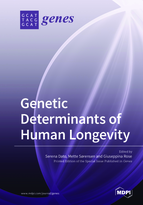Genetic Determinants of Human Longevity
A special issue of Genes (ISSN 2073-4425). This special issue belongs to the section "Human Genomics and Genetic Diseases".
Deadline for manuscript submissions: closed (31 December 2018) | Viewed by 49872
Special Issue Editors
Interests: genetic component of human longevity; aging and age-related traits; association studies; common variants; human lifespan; healthy aging; late life survival; nonagenarian sampling; genetic epidemiology; genetic data analysis
Special Issues, Collections and Topics in MDPI journals
Interests: genetic epidemiology; ageing; longevity; functional genomics;
Interests: genetics of longevity; mitochondrial contribution to aging and age-related diseases; miRNA as markers of aging
Special Issues, Collections and Topics in MDPI journals
Special Issue Information
Dear Colleagues,
In the last two decades, due to the continuous increase of lifespans in Western societies, and the consequent growing of the elderly population, have witnessed an increase in the number of studies on biological and molecular factors able to promote healthy aging and reach longevity. The study of the genetic component of human longevity demonstrated that it accounts for 25% of intra population phenotype variance. The efforts made to characterize the genetic determinants suggested that the maintenance of cellular integrity, inflammation, oxidative stress response, DNA repair, as well as the use of nutrients, represent the most important pathways correlated with a longer lifespan. However, although a plethora of variants were indicated to be associated with human longevity, only very few were successfully replicated in different populations, probably because of population specificity, missing heritability as well as a complex interaction among genetic factors with lifestyle and cultural factors, which modulate the individual chance of living longer. Thus, many challenges remain to be addressed in the search for the genetic components of human longevity.
This Special Issue is aimed to unify the progress in the analysis of the genetic determinants of human longevity, to take stock of the situation and point to future directions of the field.
We invite submissions for reviews, research articles, short-communications dealing with genetic association studies in human longevity, including all types of genetic variation, as well as the characterization of longevity-related genes.
Dr. Serena Dato
Dr. Mette Sørensen
Prof. Giuseppina Rose
Guest Editors
Manuscript Submission Information
Manuscripts should be submitted online at www.mdpi.com by registering and logging in to this website. Once you are registered, click here to go to the submission form. Manuscripts can be submitted until the deadline. All submissions that pass pre-check are peer-reviewed. Accepted papers will be published continuously in the journal (as soon as accepted) and will be listed together on the special issue website. Research articles, review articles as well as short communications are invited. For planned papers, a title and short abstract (about 100 words) can be sent to the Editorial Office for announcement on this website.
Submitted manuscripts should not have been published previously, nor be under consideration for publication elsewhere (except conference proceedings papers). All manuscripts are thoroughly refereed through a single-blind peer-review process. A guide for authors and other relevant information for submission of manuscripts is available on the Instructions for Authors page. Genes is an international peer-reviewed open access monthly journal published by MDPI.
Please visit the Instructions for Authors page before submitting a manuscript. The Article Processing Charge (APC) for publication in this open access journal is 2600 CHF (Swiss Francs). Submitted papers should be well formatted and use good English. Authors may use MDPI's English editing service prior to publication or during author revisions.
Keywords
- genetic determinants of human longevity
- genetic variation
- genetic association study
- longevity-related genes
- human lifespan









